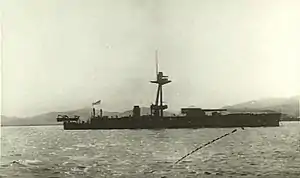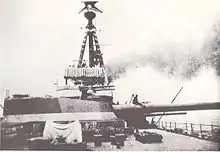Abercrombie-class monitor
The Abercrombie class of monitors served in the Royal Navy during the First World War.
 | |
| Class overview | |
|---|---|
| Name: | Abercrombie |
| Operators: |
|
| Completed: | 4 |
| Lost: | 1 |
| Scrapped: | 3 |
| General characteristics [1] | |
| Type: | Monitor |
| Displacement: | 6,150 long tons (6,250 t) |
| Length: | 334 ft 6 in (101.96 m) oa |
| Beam: | 90 ft 2 in (27.48 m) |
| Draught: | 10 ft (3.0 m) |
| Installed power: | 2,310 ihp (1,720 kW) |
| Propulsion: |
|
| Speed: | 6 1⁄2 kn (12.0 km/h; 7.5 mph) (HMS Raglan) |
| Complement: | 198 |
| Armament: |
|
| Armour: | |
| Aircraft carried: | 1 × seaplane (designed but seldom carried) |
History

The four ships in this class came about when the contracted supplier of the main armament for the Greek battleship Salamis being built in Germany was unable to supply due to the British blockade. The company – Bethlehem Steel in the United States – instead offered to sell the four 14 in (356 mm) twin gun turrets to the Royal Navy on 3 November 1914.[1] The Royal Navy was using obsolete pre-dreadnought battleships for shore bombardment in support of the army in Belgium, and a design for a shallow-draught warship (known as "Monitors") suitable for shore-bombardment was quickly designed and built to use these turrets. The ships were laid down and launched within six months.[1]
The ships carried a single main gun turret forward of a tripod mast, which was itself in front of a single funnel. A secondary armament of two 12-pounder (76 mm) guns was fitted, with a single 3-pounder (47 mm) anti-aircraft gun and a 2-pounder pom-pom completed the ships armament.[2]
The monitors had a box-like hull, with very bluff bow and stern, and were fitted with anti-torpedo bulges. In order to speed construction, it was intended to use off-the shelf merchant ship engines, giving about 2,000 indicated horsepower (1,500 kW), which were expected to drive the ships to 10 knots (19 km/h; 12 mph). The rushed design, however, meant that the ships were much slower than expected — Raglan's engines gave 2,310 indicated horsepower (1,720 kW) but the ship could only reach 6 1⁄2 knots (12.0 km/h; 7.5 mph).[3]
During the planning and build, they were to be the Styx-class named after four American figures; General Ulysses S. Grant, General Robert E. Lee, Admiral David Farragut and General Stonewall Jackson and they were launched under these names. Because the United States was still a neutral power at that time, using these names would have been undiplomatic and so they were renamed as simply M1 through M4 before completion, then receiving their final names.
The design included a seaplane for spotting the guns, but it was found that land-based aircraft were more effective; as monitors, they would never operate in the open sea, and storing the seaplane on top of the turret meant it had to be removed to avoid damage, even if not required before the guns could fire.
Ships
| Ship | Namesake | Builders | Launched | Fate |
|---|---|---|---|---|
| M1 (Abercrombie) | James Abercrombie | Harland and Wolff, Belfast | 15 April 1915 | Paid off after the Armistice and sold for scrap to TW Ward of Inverkeithing in 1927. |
| M2 (Havelock) | Henry Havelock | Harland and Wolff, Belfast | 29 April 1915 | Sold in 1921 for breaking up to TW Ward of Preston, broken up 1927 |
| M3 (Raglan) | FitzRoy Somerset, 1st Baron Raglan | Harland and Wolff, Govan, | 29 April 1915 | Sunk during the Battle of Imbros in January 1918, by Yavuz Sultan Selim and Midilli |
| M4 (Roberts) | Frederick Roberts, 1st Earl Roberts | Swan Hunter, Wallsend, | 15 April 1915 | Used as a static drillship after the First World War, scrapped in 1936 |
References
- Gardiner and Gray 1985, p. 43.
- Gardiner and Gray 1985, p. 44.
- Gardiner and Gray 1985, pp. 43–44.
Bibliography
| Wikimedia Commons has media related to Abercrombie class monitor. |
- Bacon, Reginald (1919). The Dover Patrol 1915-1917. (2 vols.). New York: George H. Doran Co. Vol. 1 • Vol. 2
- Buxton, Ian (2008) [1978]. Big Gun Monitors: Design, Construction and Operations 1914–1945 (2nd Revised ed.). Barnsley, UK: Seaforth Publishing. ISBN 978-1-84415-719-8.
- Crossley, Jim (2013). Monitors of the Royal Navy; How the Fleet Brought the Great Guns to Bear. Barnsley, UK: Pen & Sword. ISBN 978-1-78383-004-6.
- Dittmar, F. J. & Colledge, J. J., "British Warships 1914-1919", (Ian Allan, London, 1972), ISBN 0-7110-0380-7
- Dunn, Steve R (2017). Securing the Narrow Sea: The Dover Patrol 1914–1918. Barnsley, UK: Seaforth Publishing. ISBN 978-1-84832-251-6.
- Friedman, Norman (2011). Naval Weapons of World War One: Guns, Torpedoes, Mines and ASW Weapons of All Nations; An Illustrated Directory. Barnsley: Seaforth Publishing. ISBN 978-1-84832-100-7.
- Gray, Randal (ed), "Conway's All the World's Fighting Ships, 1906–1921", (Conway Maritime Press, London, 1985), ISBN 0-85177-245-5
- Parkes, Oscar; Prendergast, Maurice, eds. (1969) [First published 1919]. Jane's Fighting Ships 1919. New York: Arco Publishing Co. ISBN 978-0-71534-716-4. OCLC 1902851. Retrieved 23 December 2019.
